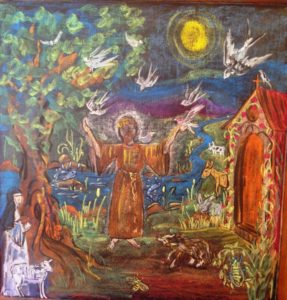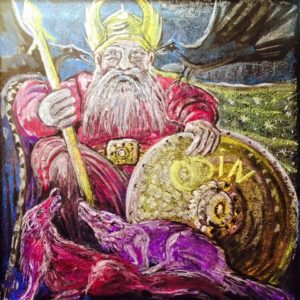Images, inspiration and transformation
Every day the main class ends with the teacher telling a story, which is chosen according to the age of the children in the class and what is important for their development at the time. These stories are also used as motive and inspiration for children to draw or paint. The types of stories used are:
Fairy tale for children from 6 to 7 years, especially those from the Brothers Grimm collection – For this child who still feels at one with the world, fairy tales are indicated because they represent broad universal images, without defined space or time. They are considered a spiritual treasure of humanity, the result of primordial experiences of human existence. They produce an unconscious effect on the soul by rescuing, through meaningful images, the entire long journey of human maturation on earth. For this reason, people of all times – especially children – have always recognized in them, albeit unconsciously, something related to their own soul. Kings, princesses, dwarves, giants – all these images – correspond to the deep inner realities of man.(1)
Fairy tales represent a real “food” for children's souls. We should never try to interpret, or find some “moral of the story”, for children. The images experienced by them will gradually mature, in each one's unconscious. In kindergarten, the stories must be told in full, at once, and must be repeated on other days, stimulating the development of memory. For children from 6 to 7 years old, in elementary school, they can already be counted in parts, and are not usually repeated. Each day, before continuing the story, the teacher encourages students to freely tell what they remember from what was told the day before.

San Francisco – blackboard drawing by teacher Beatriz Retz, from Escola Waldorf Aitiara
Fables and Legends of Saints for the children of 8 years – At this age, the child begins to perceive that he and the world are not one, a perception that culminates around the age of 9. Polarity is a fundamental issue at this age, so fables are told, which allow children to perceive human flaws revealed by the animal's characteristics, interspersed with stories of saints, which reveal our most human side, the mastery over our instincts. Passerini states that “the educational idea that guides these tales of fables and legends is to show that instincts actually exist, and that through ideal models instincts are transformed”.(2)
Old Testament Stories for the children of nine years old – The purpose is not religious. It happens that this child feels more unhappy and lonely, as he already perceives himself “outside” the world and feels that that time of magic in which he lived no longer exists. In Salles et al, the authors argue that “at the age of 9, the child, previously identified with the world around, now goes through a very special moment, moving further and further away from fantasy and from the feeling of unity and integration with nature. and with its environment. The child feels alone for the first time, he feels as an individual, separate, creating an internal space. The pedagogical task is to build a bridge between the inner space of the 9-year-old child and the world from which he is moving away.”(3)
For this, the authors indicate that it is important to bring images to children that encourage the desire to grow and act in the world as an individual. Thus, the stories of the Old Testament are told with the aim of giving them security and highlighting the importance of authority - represented by God, Abraham, Moses, by the commandments - and of courage and perseverance, based on images of the way that the Hebrew people he had to go on in order to overcome his difficulties. Passerini also clarifies that “these contents give students the courage to face their problems, by identifying with the suffering of some of the figures through their acts of courage and persistence”.(4)

Odin – blackboard drawing by teacher Beatriz Retz, from Escola Waldorf Aitiara
Stories from Norse Mythology and Archetypal Heroes for children from 10 years – This child has already overcome the crisis of 9 years old, and now sees himself more as an individual, and seeks to conquer his space in the world by measuring forces with his peers. These stories bring strong images that translate this change of consciousness that the child is going through, as they speak of honor, courage, struggle and other fundamental values. In Salles et al, the authors explain that “in Siegfried's story, the hero must forge his own sword, defeat the dragon and free the young woman imprisoned by fire: these are beautiful images that have already appeared, in a simplified form, in fairy tales, but that now, in a new guise, speak of the inner struggle that each child has at this age, moving away from childhood towards their individual path, trying to overcome impulses and conquer a loving and balanced attitude towards the world.”(5)
According to the authors, these stories were transmitted orally until the 11th century, when they were first written down, in verse, in the collection called the Ancient Edda. Around 1200 AD the Icelander Snorre Sturlason wrote the New Edda in prose.
“Each mythology expresses a soul conquest through which humanity passed, and all were very important for its evolution. The Nordics experienced intensely what makes it possible to see ourselves as individualized beings, identified as beings who think, feel and act, who have free will. […] Even as archetypal figures, the heroes reveal a life, a biography, as aspects of their birth and deeds are narrated. In fact, the legendary heroes make the bridge to the great resource that one has after the mythological consciousness ends: the biographies themselves.”(6) Sueli Passerini
Mythology stories from Atlantis to Greece are told for 11 year olds, the stories of Rome for 12 year olds, and biographies for 12 to 14 year olds.
In the video below, teacher Marisa Cristina dos Santos, from Escola Waldorf Aitiara, teaches how to tell fairy tales.
Bibliography
1) STEINER, Rudolph. The Fairy Tales. 2002, p.div.
2) PASSERINI, Sueli Pecci. Ariadne's Thread: A Path to Storytelling. 2004, p. 123.
3) SALES, Ruth. Theater at School – vol.2. Pedagogical guidelines by Cristina MB Ábalos, Dora R. Zorsetto Garcia and Vilma L. Furtado Paschoa. 2007, p. 15.
4) Idem PASSERINI, op. cit., p.124.
5) SALES, Ruth. Theater at School – vol.3. Pedagogical guidelines by Cristina MB Ábalos, Dora R. Zorsetto Garcia and Vilma L. Furtado Paschoa. 2007, p. 16.
6) PASSERINI, Sueli Pecci. Ariadne's Thread: A Path to Storytelling. 2004, p. 129.
***


